Welcome to another article about SaaS, this time covering everything about software as a service’s business model. Why do we think you need it? Well, SaaS products flooded the market. Its market alone worth nearly $200 billion in 2024, which makes it one of the most popular software types.
Hence, the idea behind the article is to guide you through all the intricate behind-the-scenes aspects of the SaaS business model. So, if you’re looking to build a SaaS product, you’re in the right place! In this piece, we will cover the most interesting part: how SaaS earns money.
In other words, hop on to learn about different SaaS business models and handy metrics to help you evaluate the success.
SaaS business models types
As the market evolves, different SaaS business models appear. Obviously, each of them is unique and suits different scenarios. Nonetheless, some of those models are proven to be effective. They can be met in numerous products we use regularly. So, let’s take a look.
Freemium
Notably, freemium is a wordplay based on the words ‘free’ and ‘premium.’ This model is common in SaaS business thanks to the flexibility it offers to users. Furthermore, it has a relatively simple strategy.
Generally speaking, the company offers two ways to use its services with this model. The first is a free product with basic functionality available to the user. Often, its functionality is limited, but it is enough to try out the app and see if you like it. The free version of the product is typically enough to attract a solid customer base but not comprehensive enough to satisfy the needs.
Another way opens when the user gets satisfied with the free functionality and decides to stick with the premium version of the content. Accordingly, users can subscribe to gain access to more advanced features, paid upgrades, or an ad-free experience. Here’s a visualization of the flow in the freemium model.
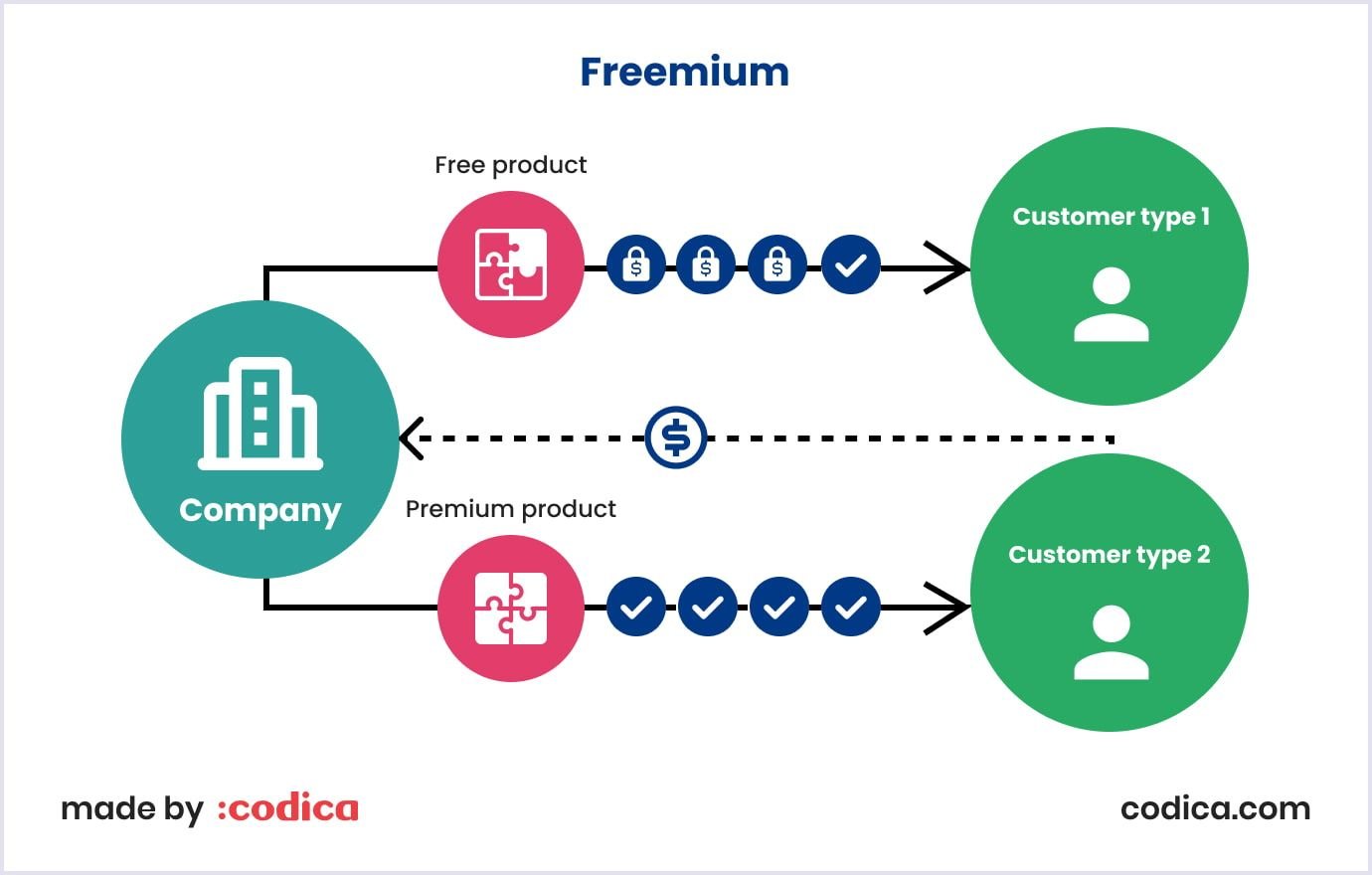
Overall, the freemium model has several solid advantages. It allows SaaS companies to acquire a sufficient user base to expand their presence in the market efficiently. Besides, the freemium model is a reliable revenue generator because it is highly customizable in time and pricing.
Nonetheless, implementing the model requires thorough planning to ensure two core aspects:
- To attract customers and give the feeling that there’s more to discover, the free version of the product has to be compelling enough.
- The premium version has to be immersive enough to keep the existing users entertained and satisfied. Besides, it has to be regularly updated with the content (if applicable) and responsive to user suggestions or reviews.
Flat pricing
Next up: a flat pricing model! It represents a strategy where a SaaS company offers its software for a fixed price for a specific time period. In a nutshell, customers have to pay a flat fee and can use the software without limitations and additional charges. More importantly, the number of users covered with the subscription and the amount of usage aren’t the case.
This model is quite popular among companies because it's streamlined and reliable. It is preferred in companies that offer a specific kit of features or functionality instead of customizable options. Flat pricing is transparent and trustworthy, which allows it to attract more customers and increase conversion rates.
Basecamp, a project management tool, features a wonderful implementation of this model. It is often referred to as the “one-size-fits-all” model, which clearly describes the idea of it. The same is with Basecamp, as they offer everything for a transparent price, which you can adjust to paying monthly or yearly.

The only notable drawback is that flat pricing may not suit all SaaS businesses. Any product with a complex pricing strategy or custom options won’t benefit from the straightforward method this model provides.
Usage-based pricing
Usage-based pricing involves charging users based on the amount of content or resources they use. Hence, the more users consume, the bigger the final bill. Usage-based pricing is not quite popular in SaaS, but certain companies still use it. This pricing model may not be popular since monetizing certain types of content is impossible based on the usage volume. For example, it would be inappropriate for Netflix to charge users for each episode they watch. You get the idea.
This model is used in utility-minded services and apps. For instance, it is commonly used in API-providing companies that charge users based on the number of API calls they make. Here’s an example of how OpenWeather allows different numbers of API calls depending on various subscription options.

In a nutshell, the scheme is pretty simple. Depending on your chosen plan, you have limited API calls available. Consequently, the more expensive options offer more calls.
Nonetheless, usage-based pricing can be suitable for products that offer custom usage patterns. Customers pay for what they need rather than the predefined features they might not want. Basically, this concept sounds quite comfortable, as users can have changing needs. Thus, they only benefit from the value and transparency.
On the one hand, the provider is obliged to create high-quality content, efficiently use the resources, and optimize the platform.
On the other hand, the customer has to effectively use and manage the resources given and avoid exceeding the limits or waste. Thus, usage-based pricing mediates qualitative cooperation between users and SaaS providers.
Related reading: Best SaaS startups in 2024
Per-user pricing
This SaaS business model pricing is designed to generate revenue based on the number of users accessing the software. In this matter, the SaaS-providing company changes a fixed price for each customer who uses the software. Usually, they operate on a monthly or annual basis.
Typically, this pricing model is the most common among companies heavily relying on teamwork and online collaboration. Thus, the per-user pricing model is very profitable yet flexible in terms of scaling itself.
For instance, it can be adjusted to offer a single-person or enterprise-level subscription. Teams also benefit from this model as it allows them to scale their usage of the software as they grow while also providing predictable costs that can be budgeted.
Read also: Exploring the Benefits of SaaS: Innovate, Scale, Succeed
Tiered pricing
At its core lies the idea of providing different pricing plans where each plan has a different set of features and functionality depending on the price threshold. Typically, pricing caps are organized in tiers, each offering a progressively higher level of service.
In this matter, the cheapest versions provide everything for comfortable usage, covering all the basic functionality, yet with minor limitations that are important to some users. Here’s the most common implementation of this model by DocuSign.
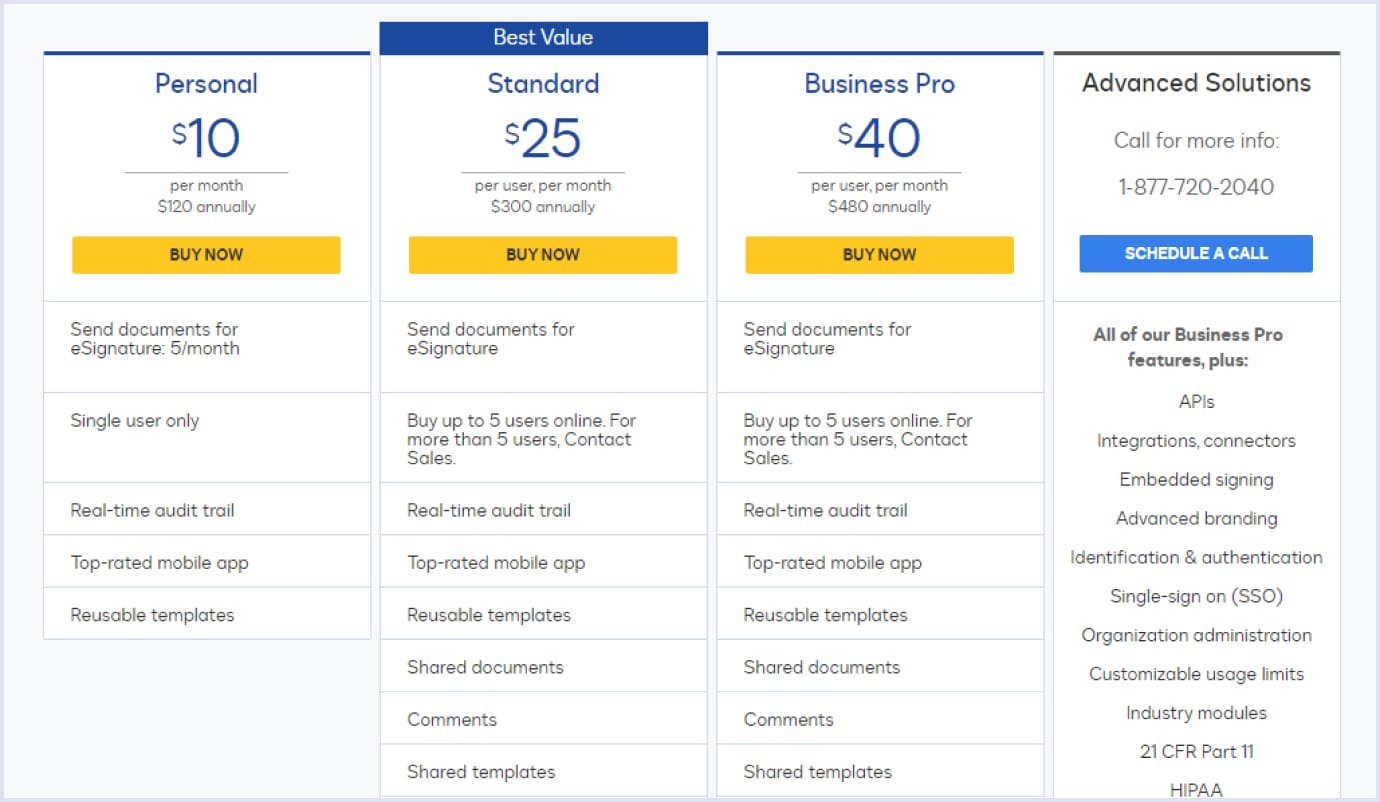
The main advantage of tiered pricing is that it offers users a variety of choices that best meet their needs. Thus, thanks to the flexibility, this model allows SaaS companies to cover a much broader audience and quickly grab attention.
Hybrid pricing
This pricing model is often an amalgam of all of the above-mentioned options. Normally, it combines two or more different pricing models into one. For example, a product can offer a base subscription fee for a certain service and add more paid options along the way. For instance, game publishers can make their games free but add in-app purchases. Also, they can allow players to access online mode via subscription.
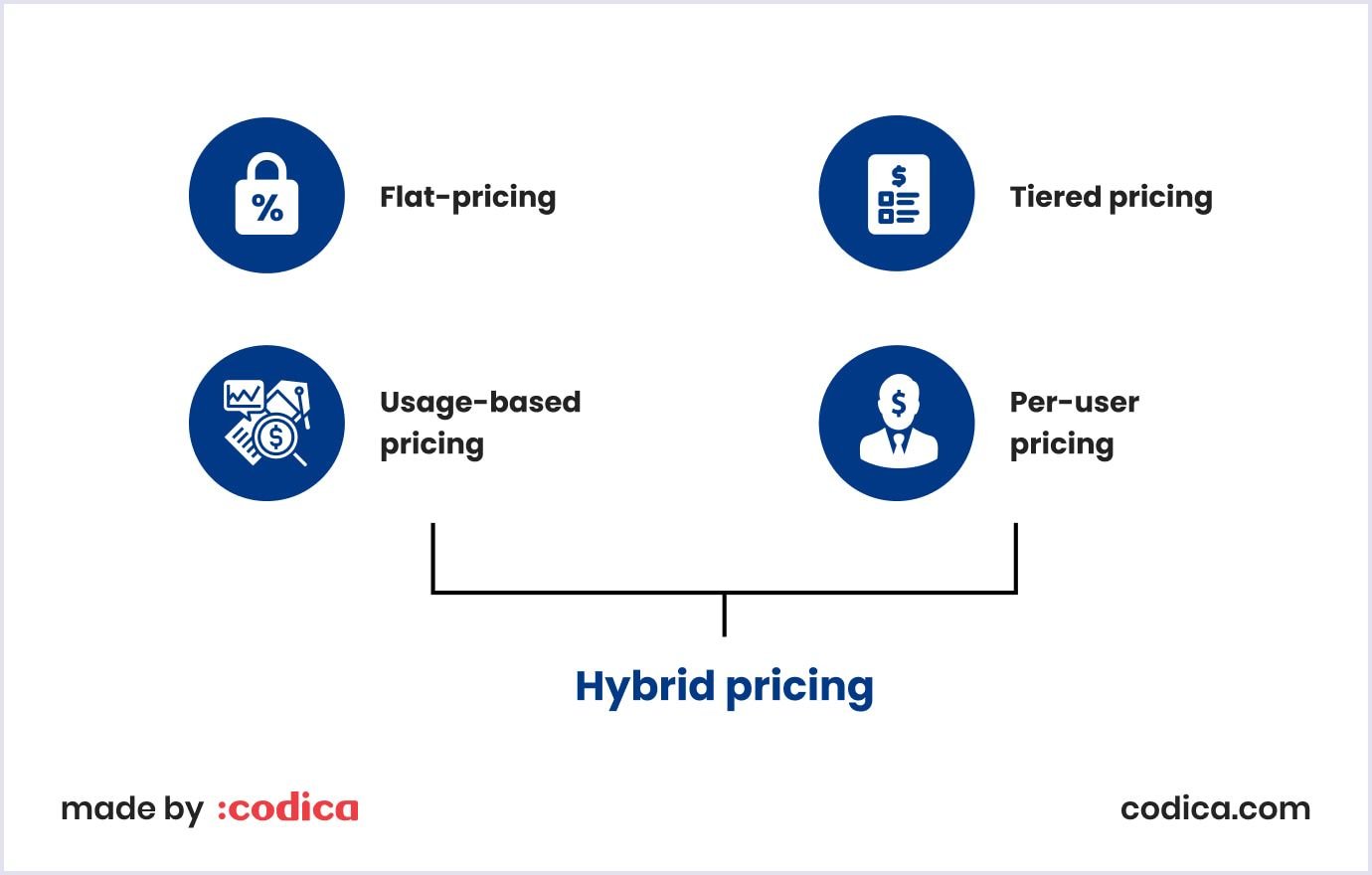
It’s worth noting that the hybrid SaaS business models quickly spread their narratives all over the market. Why?
Easy: it is highly customizable. Most modern apps are quite flexible, combining numerous features and services. Thus, applying a hybrid model allows them to effectively monetize the content, leaving room for the customers to choose what they want.
SaaS business model metrics
Tracking SaaS products’ performance is a vital part of the whole business. There are numerous helpful metrics to evaluate different aspects of your app. Some of them are users’ interest, churn percentage, and retention rate. Thus, understanding how to work with them may open new ways for improvement and potential updates.
Lifetime value (LTV)
The lifetime value metric is an essential component of long-term revenue planning. Generally speaking, it calculates the amount of revenue a customer can generate throughout the entire usage time.
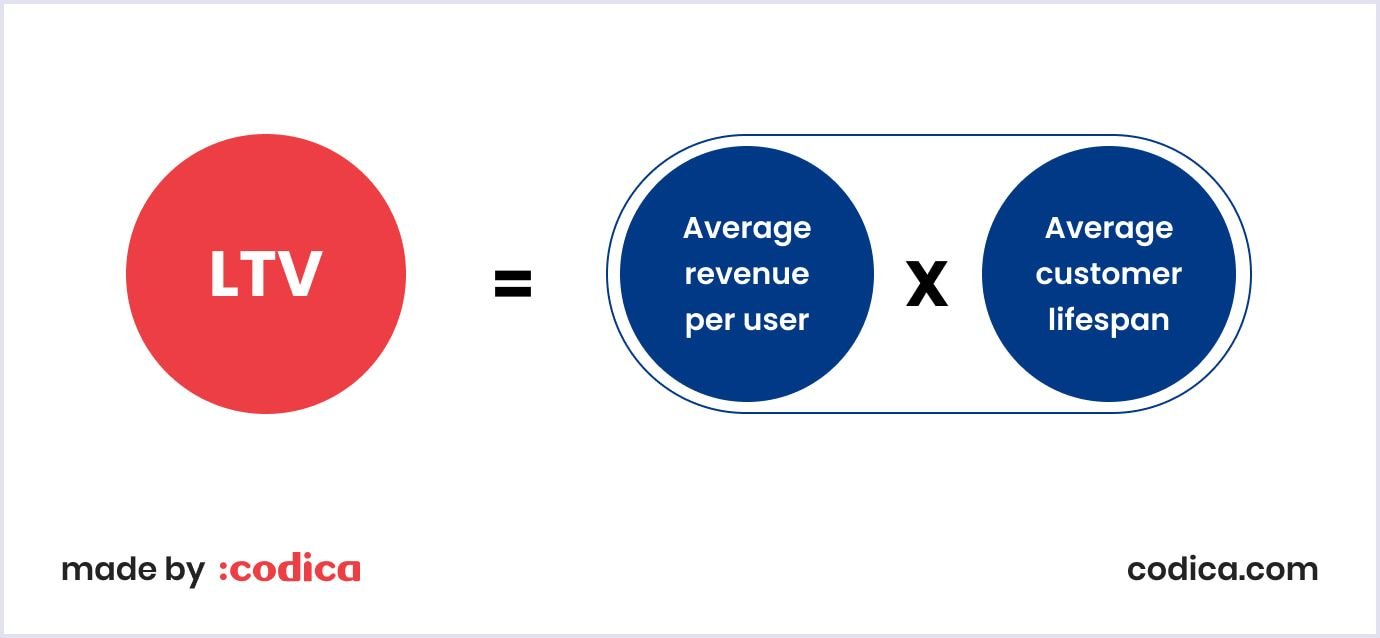
Besides, it works fairly simply. You can calculate LTV by multiplying the average revenue per user (ARPU) by the customer’s average length of time they stay subscribed to the service. Analyzing LTV helps SaaS companies predict customer acquisition costs and compose viable pricing strategies.
Customer acquisition cost (CAC)
This metric calculates the total cost a business incurs to obtain one new customer. Why there’s a need for CAC? If the company has an estimate of how much it costs to attract one, then it will be easier to figure out how much investment is required to obtain 1000 new customers. Thus, CAC can easily scale and become a resultative tool with the right analytical approach.
Typically, you can calculate CAC by dividing the total cost of acquiring new customers by the number of new customers acquired during a specified time period. For more understanding, let’s imagine a SaaS business spent $10,000 and acquired 100 new customers over this time period. Thus, the CAC would be $100.
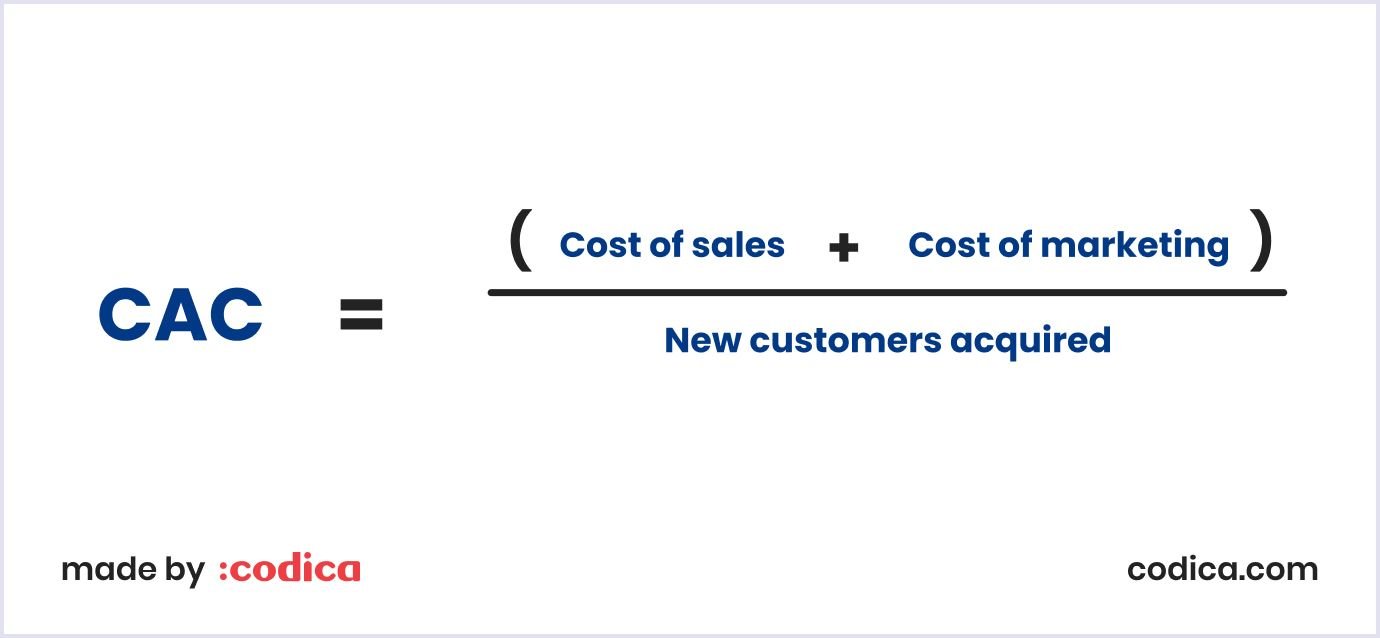
Monthly and annual recurring revenue (MRR and ARR)
MRR and ARR are essential metrics for measuring a SaaS business's performance. MRR stands for the amount of recurring revenue that the company earns on a monthly basis. It is calculated by normalizing your recurring revenue into a monthly amount.
On the other hand, ARR is the annual recurring revenue normalized in a year span. Obviously, ARR is calculated by multiplying MRR by 12.

Why is it useful?
Predicting how much your company can generate with the current customer base in a month and a year can significantly simplify the planning process. Moreover, regularly tracking both ARR and MRR can help identify trends and people’s reactions to updates. The latter, in turn, allows you to make data-driven improvements.

Churn rate
This measurement defines the percentage of customers who stop using a service during a period. Churn rate is so far the most popular metric, thanks to its simplicity. For instance, a 10% churn rate occurs when the company has 100 customers and loses 10 of them during the month.
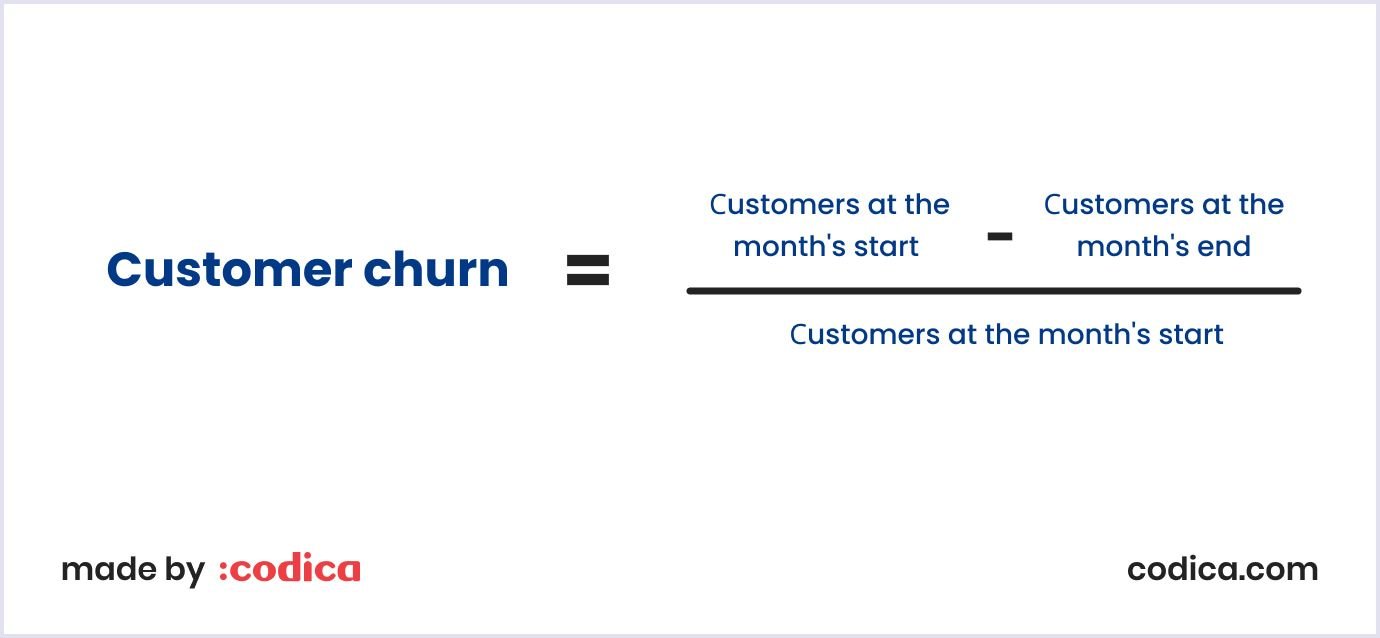
As you can see, each part of the churn rate equation is a variable that can be fed with different numbers and time periods. Thus, its flexibility allows analyzing your customer base's likings and their reaction to the content of your SaaS product.
Besides, it is a fundamental metric to be acknowledged, as the churn rate is one of the most crucial aspects of successful growth.
Related reading: Why SaaS Startups Fail: Most Common Reasons and How to Prevent Them
Retention rate
The exact opposite of the churn rate, the retention rate represents the percentage of users who keep using a product over a given period. Calculating the retention rate is also fairly simple. Normally, analysts define a specific time period, take the total number of users from the beginning of the period, and see how many of them continue to use the product by the end of the chosen period. This metric is especially useful to identify the loyalty and satisfaction of your users.

Proper retention rate treatment can do wonders with your startup. It’s an extremely important metric to take advantage of, as it’s very helpful in managing your audience. Besides, it is even more crucial in a SaaS environment because most software solution companies rely highly on their audience.
Understanding the combination of all metrics listed above can seriously improve your startup's progress. Moreover, regular analysis can reveal the lacking points of your product in their forming period. Hence, you will have enough time to eliminate them.
Codica’s expertise
Speaking of the experience with SaaS, we’re no strangers to creating various solutions in this niche. At Codica, we had a chance to work on the SaaS solution to eliminate administration hustle from the creative environment and business relations. Thus, we developed a highly performant and reliable SaaS platform for bakery business.
In our SaaS development services, we adhered to the best development practices, which resulted in catchy UI/UX design, optimized performance, payment security measures, and advanced third-party integrations. Let’s admire a little, shall we?
Regarding the mission of the startups, in cooperation with our client, we decided to stick to a minimalistic approach in business model choice. Hence, we developed two-tiered pricing with two purposes: to give users a choice and not overwhelm them.
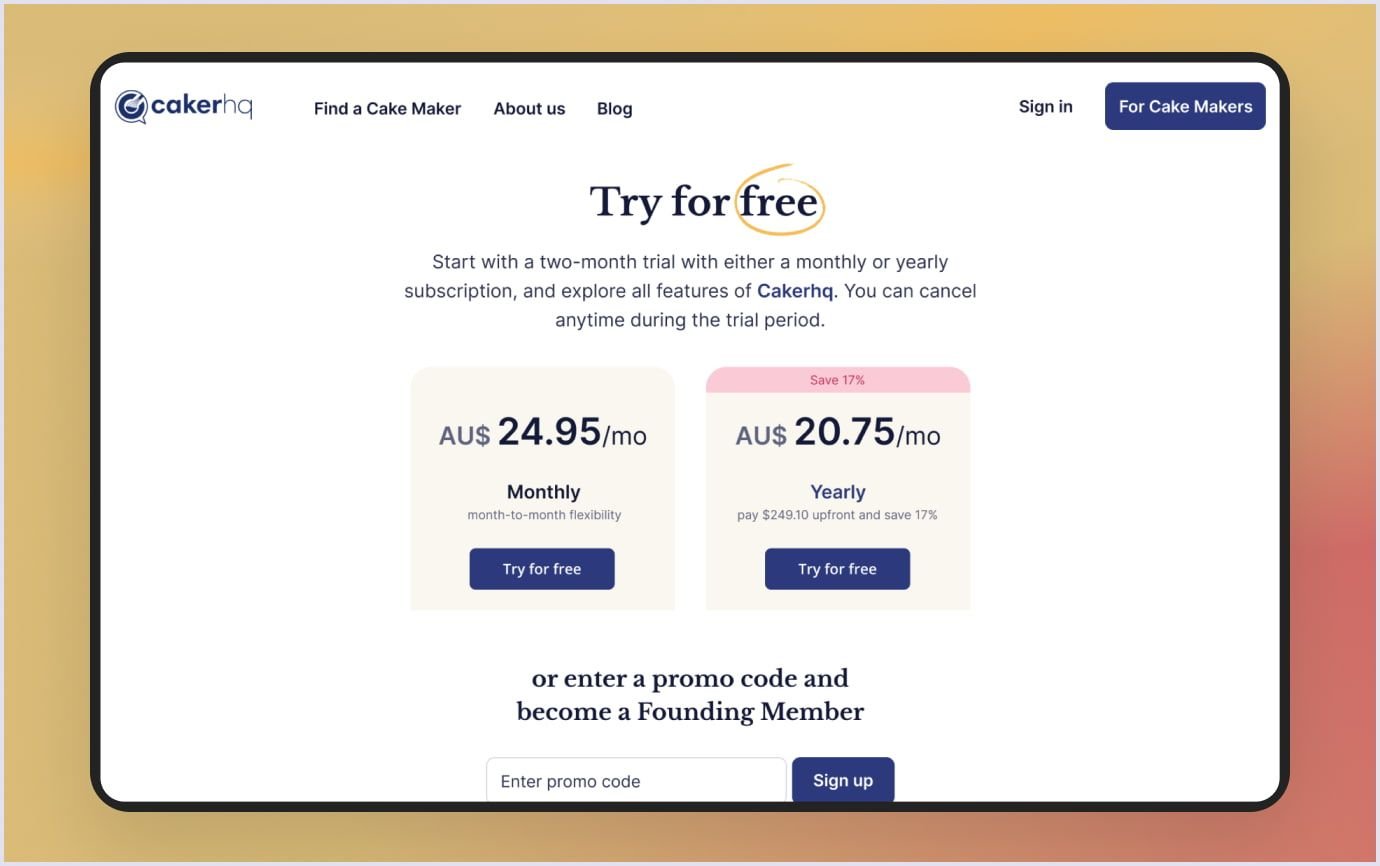
As a result, a combination of a free trial and only two subscription options became a no-brainer and greatly simplified customers’ acquaintance with the platform.
Conclusion
Summing everything up, the business model choice for your startup is a very important step. After looking at various types of SaaS business models, helpful metrics, and examples, it is clear that the success of your business highly relies on the monetization you choose. Hence, this step requires thorough planning and analysis to make your way to the market efficiently.
In this matter, Codica is always up to becoming your reliable partner. Over the years, we developed strong expertise in consulting our clients in various fields. Apart from SaaS as a business model, we are keen on building marketplaces, PWA solutions, mobile apps, and MVPs. If you are excited as we are, feel free to check our portfolio.
Finally, if you have an idea to start your SaaS business and shake the market – embrace the challenge. You will have to go from the idea glimpse to a fully operating company on your own. However, entrust this matter to professionals and contact us if there's even the slightest doubt.
